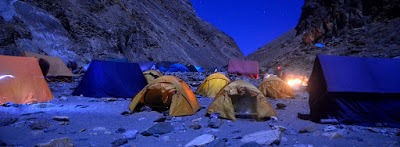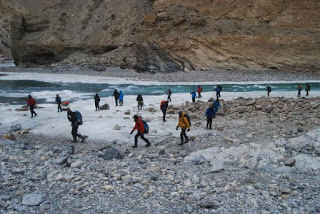Leave the Chaddar alone
Come winter, many rivers and lakes freeze in the high Himalaya. A natural phenomenon. But not all frozen rivers have a significance. The Zanskar river does. When it freezes over in winter, it becomes the viable route to reach Leh for the Zanskaris, who are otherwise cut off from all civilization. But its not an adventure for them, it’s a need. They understand the perils of walking on a frozen river in a deep gorge. They pray to the spirits of the Zanskar to let them cross safely. The river is sacred for them.
Then there is our world. Where we have made things easy for ourselves. Where we have built a shield between us and nature. Where we crave for that one act of bravery and adventure to establish our worth. And that one act has to be the highest, the wildest, the scariest, the best. What it can not be, is unknown. And we therefore turn our gaze, along with thousand others, to the Everest base camp, the villages of Spiti and the Chaddar trek over Zanskar.
Since 2011, when it was featured in a BBC documentary and subsequently termed as “the wildest trek in the world”, there has been a 100-fold increase in the number of people going for the Chaddar trek. Where just about 100 Zanskaris will walk over the river in the roughly two months its frozen, more than 7000 trekkers went for the trek in 2016, camping in overcrowded filthy sites along the river.
 Pic source - Chadartrekladakh.in
Pic source - Chadartrekladakh.in
1 river. 100+ trekkers a day. How much bio waste is generated daily? Where does it go? The sacred Zanskar. The river which is the lifeline of the locals. What about the heat generated? How much has it raised the average temp? Its effect on the river? If the river is not frozen, it means abandoning the trek for the visitors, but for locals it means taking the far riskier route along the sides of the steep gorge.
And then, the trekking ethics. Do the trekkers going for Chaddar understand the geography, the ecology, the culture of this place? Do they understand the ethos of trekking without leaving a trace? Have they trekked before in the Himalaya? Have they understood the gradual change in terrain, in weather, in the entire way of life as one moves from the lower hills to the meadows and streams of middle Himalaya and then to the passes across the Greater Himalaya connecting to the trans-Himalaya? Have they just flown over the whole expanse of Himalaya to land straight in Ladakh? And then followed behind a long line of other trekkers with their bags hauled by porters, utterly and completely dependent on them? Do they really believe this is the wildest trek in the world?
 Pic source - The Hindu businessline
Pic source - The Hindu businessline
The Chaddar trek has (unfortunately) become the marker of how much you don’t care for the ecology of the Himalaya, the ethics of trekking and the culture and rights of local people.
Himalaya has a lot to offer. Don’t be greedy. Spread out.
Then there is our world. Where we have made things easy for ourselves. Where we have built a shield between us and nature. Where we crave for that one act of bravery and adventure to establish our worth. And that one act has to be the highest, the wildest, the scariest, the best. What it can not be, is unknown. And we therefore turn our gaze, along with thousand others, to the Everest base camp, the villages of Spiti and the Chaddar trek over Zanskar.
Since 2011, when it was featured in a BBC documentary and subsequently termed as “the wildest trek in the world”, there has been a 100-fold increase in the number of people going for the Chaddar trek. Where just about 100 Zanskaris will walk over the river in the roughly two months its frozen, more than 7000 trekkers went for the trek in 2016, camping in overcrowded filthy sites along the river.
 Pic source - Chadartrekladakh.in
Pic source - Chadartrekladakh.in1 river. 100+ trekkers a day. How much bio waste is generated daily? Where does it go? The sacred Zanskar. The river which is the lifeline of the locals. What about the heat generated? How much has it raised the average temp? Its effect on the river? If the river is not frozen, it means abandoning the trek for the visitors, but for locals it means taking the far riskier route along the sides of the steep gorge.
And then, the trekking ethics. Do the trekkers going for Chaddar understand the geography, the ecology, the culture of this place? Do they understand the ethos of trekking without leaving a trace? Have they trekked before in the Himalaya? Have they understood the gradual change in terrain, in weather, in the entire way of life as one moves from the lower hills to the meadows and streams of middle Himalaya and then to the passes across the Greater Himalaya connecting to the trans-Himalaya? Have they just flown over the whole expanse of Himalaya to land straight in Ladakh? And then followed behind a long line of other trekkers with their bags hauled by porters, utterly and completely dependent on them? Do they really believe this is the wildest trek in the world?
 Pic source - The Hindu businessline
Pic source - The Hindu businesslineThe Chaddar trek has (unfortunately) become the marker of how much you don’t care for the ecology of the Himalaya, the ethics of trekking and the culture and rights of local people.
Himalaya has a lot to offer. Don’t be greedy. Spread out.
Published on February 04, 2017 00:53
No comments have been added yet.



